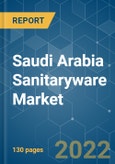In the last few years, the market for sanitary products in Saudi Arabia has grown significantly. In the Gulf Cooperation Council, Saudi Arabia has emerged as one of the most important manufacturing centers for cleaning products. The growth of the market is driven by government initiatives to promote housing affordability and an increase in demand from businesses and industries, for instance, hotels, offices, schools, and universities. In view of the increasing demand for housing from both local and immigrant populations, the real estate sector is expected to continue to experience healthy growth. It is anticipated that this will continue to drive the growth of the sanitary ware product market. Moreover, the growth of demand is expected to be driven by a growing purchasing power for consumers.
Smart home adoption and infrastructure developments in the world are expected to have a positive impact on the demand for hygiene products. Moreover, demand for sanitary products in the housing sector is being driven by changes in building interiors. As homeowners upgrade their existing sanitary ware to newer products that offer better visual appeal or function, residential remodels and replacements are likely to continue to represent the majority of demand for ceramics sanitary ware.
As consumers and producers seek to meet sustainability standards, there is a growing demand for these products from the adoption of strict guidelines and incentives on energy-efficient toilet installations. Disposable income has also increased, allowing more people to spend on quality sanitary products as a result of the growth of the real estate sector and the growing middle class in emerging economies.
Saudi Arabia Sanitaryware Market Trends
Sanitary Ware in Saudi Arabia is in High Demand Due to the Increasing Demand for Residential Construction in Saudi Arabia.
Due to the high demand for houses in Saudi Arabia, the real estate sector has grown significantly. The demand for sanitary ware products in the housing sector has always been the backbone of the sanitary ware market. The increasing domestic consumption, the growing population, the growing urbanization, the nuclear family trend, etc., have resulted in a higher demand for houses than in earlier times. Due to the high disposable income of the people in Saudi Arabia, they can buy apartments. The domestic sanitary ware demand of the country is mainly driven by the growth of construction activities and the growing demand for housing.The luxury sanitary ware market’s growth in Saudi Arabia is mainly driven by luxury housing and smart homes to improve lifestyle concerns about water consumption, rising awareness of water scarcity issues, and surging demand for luxury fixtures in the residential sector. Luxury sanitary ware market penetration in Saudi Arabia is expected to be driven by increasing consumer spending on home renovation due to increasing affordability. Product demand is anticipated to grow as more energy-efficient products are adopted in residential and commercial settings, which will contribute to the overall market’s growth in Saudi Arabia over the period in analysis.
Ceramics is One of the Most Widely Used Materials for Sanitary Ware Production
Saudi Arabia’s sanitary ware market is driven by technological innovation and customer demand for advanced, personalized bathroom products. In addition, increasing hygiene concerns are driving the need for touchless urinal, cistern, and wash basin solutions that prioritize safety, reduce contamination risk, and maintain a constant water temperature. As consumers become more aware of health and sanitation issues, the demand for sanitary ware is expected to grow. The tightening of government regulations on the construction and usage of public restrooms will further stimulate the market for sanitary ware. The government will also continue to provide guidance and support for hygiene and sanitation education. The construction industry is expected to adopt sanitary ware due to its affordability, chemical and scratch damage resistance, and changing consumer preferences toward luxury items. The hospitality industry is expected to grow due to the increase in infrastructure spending and the growth of tourism in Saudi Arabia.Saudi Arabia Sanitaryware Industry Overview
The Saudi Arabian sanitary ware market is moderately fragmented. These market leaders implement key marketing tactics like product and service launches, mergers and acquisitions, partnerships and collaborations, and joint ventures. They also invest in innovation and expansion to increase their market share. However, as technology advances and new products are developed, mid-sized to small-sized companies are gaining market share by signing new contracts and entering new markets. Some of the major players dominating the market are Saudi Ceramics, Forsan Ceramics, RAK Ceramics, Casa Via, and Arabian Company for Ceramics.Additional Benefits:
- The market estimate (ME) sheet in Excel format
- 3 months of analyst support
This product will be delivered within 2 business days.
Table of Contents
Companies Mentioned (Partial List)
A selection of companies mentioned in this report includes, but is not limited to:
- Saudi Ceramics
- Forsan Ceramics
- RAK Ceramics
- SIDC Ceramic Plant (Casa Via)
- Porsalina Ceramics
- Arabian Company for Ceramics
- Geberit International
- Ceramica Cleopatra
- Kohler
- Hocheng Corporation*
Methodology

LOADING...








